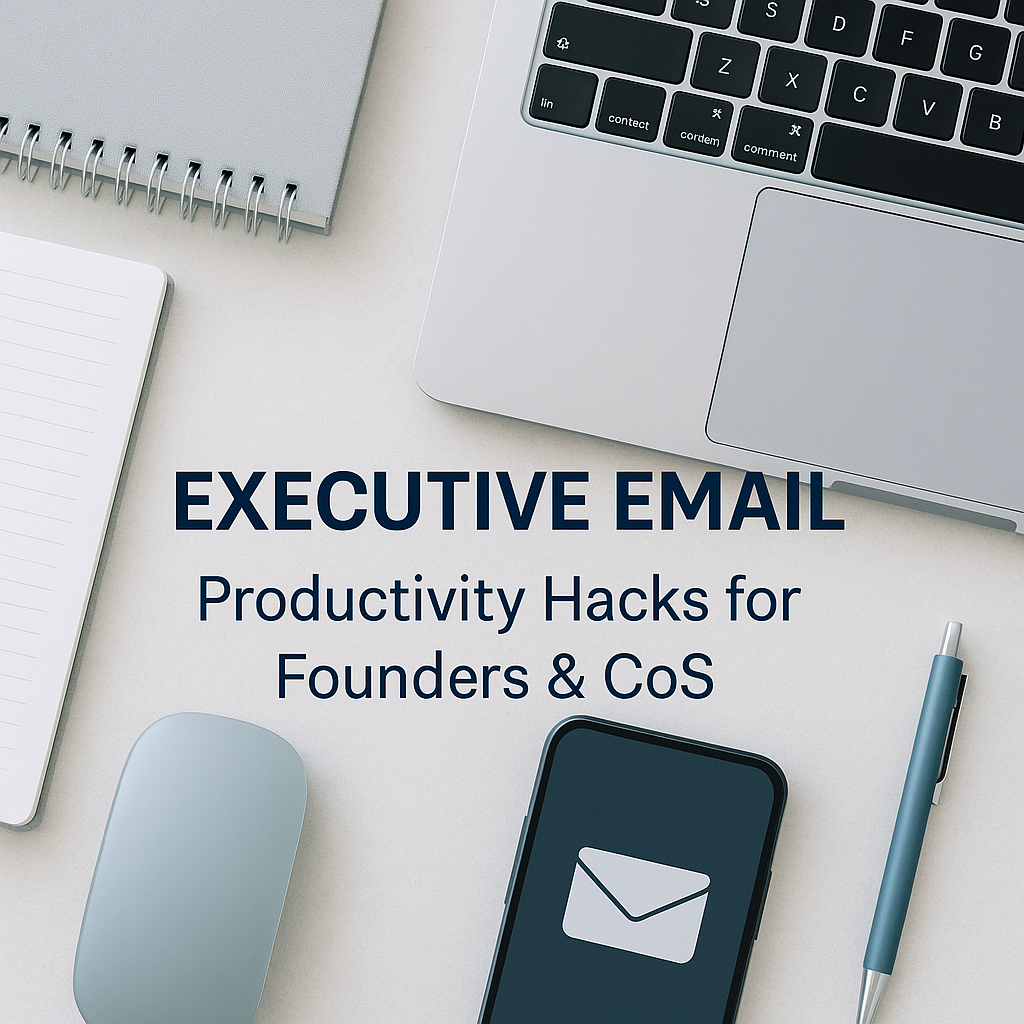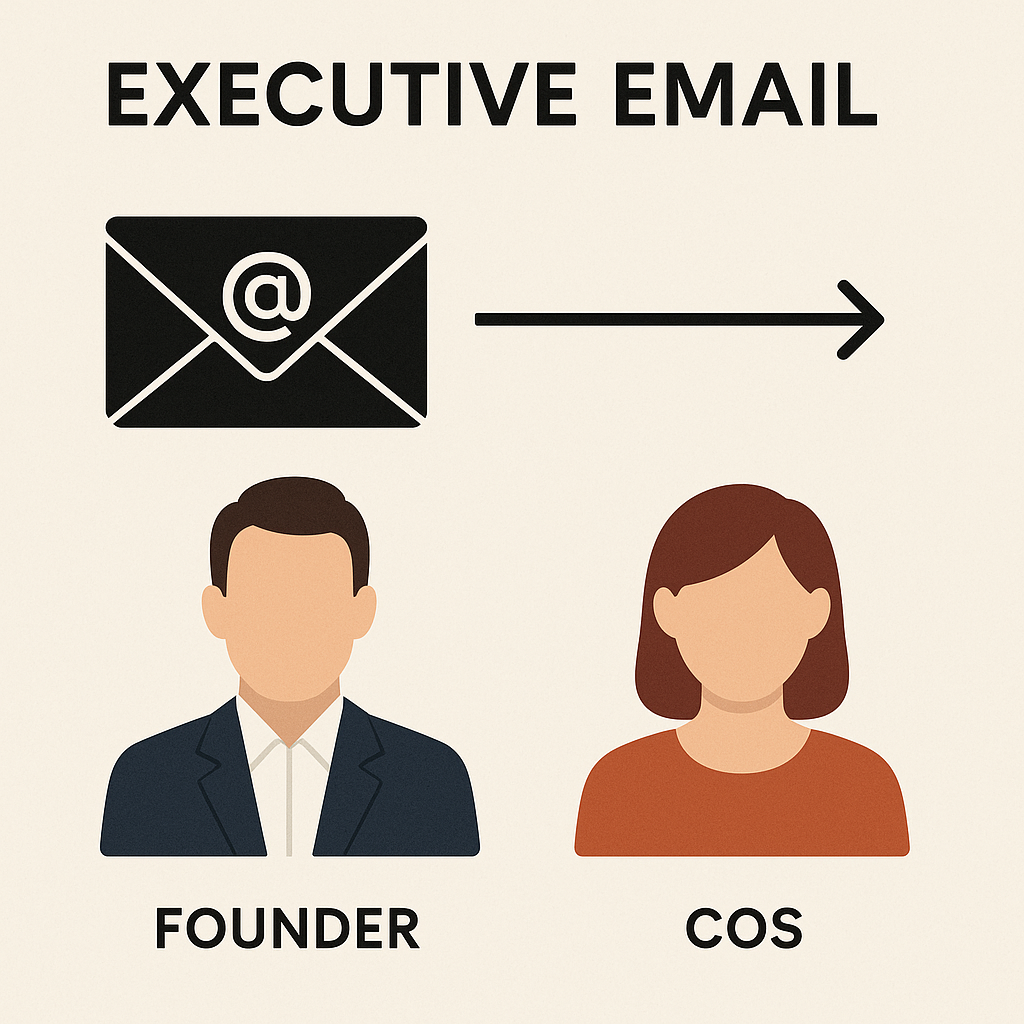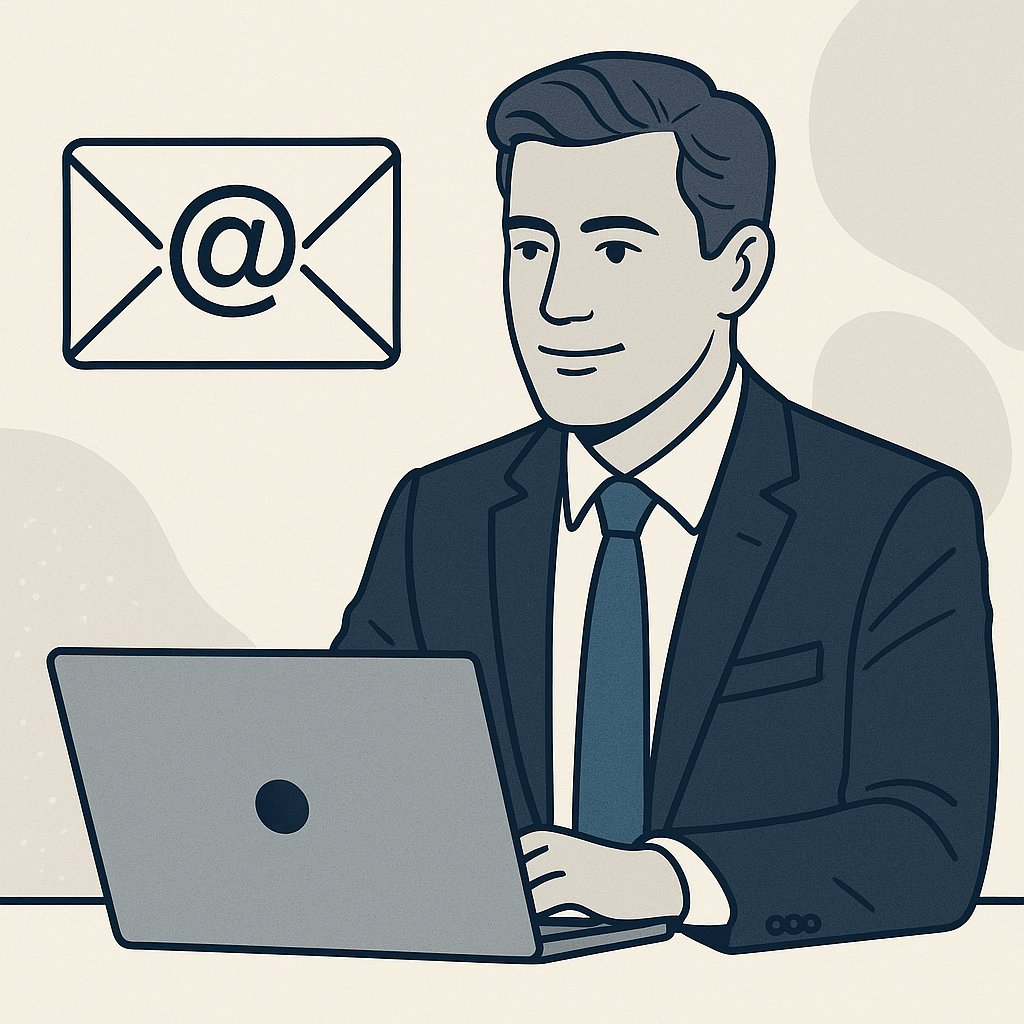Executive Email: Productivity Hacks for Founders & CoS

In the fast-paced world of startups and growing enterprises, founders and their Chief of Staff (CoS) are often the central hubs of communication. While crucial for driving the business forward, this constant flow of information, predominantly through email, can quickly become a significant bottleneck. The executive inbox, a daily deluge of requests, updates, and decisions, can easily consume precious hours that should be dedicated to strategic planning, team leadership, and visionary thinking. Mastering executive email communication isn't just about managing messages; it's about reclaiming your time, enhancing your impact, and ensuring that critical tasks and opportunities don't get lost in the digital noise. This article delves into practical strategies for email management for founders and CoS, focusing on how to streamline your inbox, communicate with greater impact, and leverage modern tools, including AI, to boost overall productivity.
Understanding Executive Email Etiquette and Best Practices
Before diving into advanced techniques, it's essential to lay a foundation in solid executive email etiquette. For founders and CoS, every email sent reflects not only on their personal brand but also on the company's professionalism. Inconsistent or poor email practices can lead to misunderstandings, delays, and a perception of disorganization.
The Pillars of Professional Executive Communication
- Clarity and Conciseness: Executives are time-poor. Get straight to the point. State your purpose early and avoid unnecessary jargon or lengthy introductions.
- Professional Tone: Maintain a respectful and professional demeanor, even in urgent situations. Avoid overly casual language, excessive exclamation points, or emotional responses.
- Action-Oriented Subject Lines: Craft subject lines that clearly indicate the email's content and urgency. For example, "Action Required: Q3 Budget Approval by EOD" is far more effective than "Budget."
- Promptness and Expectation Management: Aim to respond to emails within a reasonable timeframe. If a full response will take time, send a brief acknowledgment stating when they can expect a detailed reply.
- Proofreading: Always take a moment to proofread for typos, grammatical errors, and clarity. Errors can undermine your credibility.
- Appropriate Use of CC and BCC: Use CC sparingly for those who need to be informed but don't need to act. Use BCC to protect privacy or manage large recipient lists without revealing addresses.
As noted by Forbes, "Emailing is the primary way in which I communicate with my clients and partners. In order to remain organized, I have a folder for each of the entities that I work with where I catalog all of the emails." This highlights the importance of structured communication and organization from the outset.
Strategies for Efficient Executive Email Management
The sheer volume of emails can be overwhelming. Implementing effective management strategies is crucial for maintaining control and ensuring that your inbox serves as a tool, not a torment.
Prioritization Techniques
Not all emails are created equal. Founders and CoS need to quickly identify and address what matters most. Consider these methods:
- The Eisenhower Matrix: Categorize emails based on urgency and importance.
- Urgent & Important: Do immediately.
- Important, Not Urgent: Schedule time to do.
- Urgent, Not Important: Delegate if possible.
- Not Urgent, Not Important: Delete or archive.
- VIP Flagging: Identify key stakeholders (investors, critical clients, direct reports) and create filters or rules to bring their emails to your attention immediately.
- Keyword Alerts: Set up alerts for specific keywords that indicate high priority, such as "urgent," "critical," or project-specific terms.
Inbox Organization Systems
A cluttered inbox leads to missed information. Implementing a system can make a significant difference:
- Folder/Labeling System: Create a logical folder structure. Common approaches include:
- By Project/Client
- By Action Required (e.g., "To Do," "Waiting For," "Review")
- By Department/Team
- The "Two-Minute Rule": If an email can be dealt with in under two minutes (e.g., a quick reply, archiving), do it immediately.
- Batch Processing: Instead of checking email constantly, set specific times during the day to process your inbox. This minimizes context switching and improves focus.
- Ruthless Unsubscribing: Regularly unsubscribe from newsletters, marketing emails, and notifications that don't provide significant value.
For those looking to master their inbox, exploring tools that offer advanced filtering and management can be beneficial. Consider how an admin virtual assistant can help implement and maintain these systems for you.
Leveraging AI Tools for Enhanced Executive Email Productivity (Focus on MailToPie)
The digital age has brought forth powerful tools designed to alleviate the burden of overwhelming inboxes. Artificial Intelligence (AI) is at the forefront of these innovations, offering solutions that can automate, optimize, and enhance how founders and CoS manage their executive email communications.
The AI Advantage in Email Management
AI-powered tools can go beyond simple filtering and sorting. They can learn your preferences, predict your needs, and proactively manage your inbox, freeing up significant mental bandwidth. These tools are becoming indispensable for anyone looking to streamline business emails and improve executive inbox organization.
AI can assist with:
- Intelligent Sorting and Prioritization: AI algorithms can learn to identify urgent requests, important contacts, and recurring tasks, automatically flagging or moving them to designated folders.
- Automated Drafting and Responses: AI can draft routine emails, suggest replies based on context, and even summarize long email threads, drastically reducing the time spent typing. Tools like an ai executive assistant are specifically designed to handle these complex tasks, acting as a force multiplier for your communication efforts.
- Task Extraction: AI can scan emails for action items, deadlines, and meeting requests, helping you create to-do lists or calendar entries automatically.
- Sentiment Analysis: Some advanced tools can gauge the tone of incoming emails, helping you prepare for sensitive conversations or prioritize communications requiring immediate, careful attention.
By integrating AI into your workflow, you can transform your email management from a reactive chore into a proactive, efficient process. Exploring an AI email assistant can unlock new levels of productivity, allowing you to focus on higher-value activities. For those interested in a broader overview of how AI can optimize workflows, an article on AI workflow can provide further insights.
For founders and CoS seeking to truly master their inboxes, leveraging a sophisticated AI email assistant is no longer a luxury but a necessity. These platforms can significantly enhance your chief of staff email strategy by automating repetitive tasks, ensuring timely responses, and helping you maintain a clear overview of your communications.
Crafting High-Impact Executive Emails: Clarity, Conciseness, and Tone
Once your inbox is under control, the focus shifts to the quality of your outgoing communication. Effective executive emails are clear, concise, and convey the right tone to achieve their intended purpose.
The BLUF Principle and Effective Structuring
Bottom Line Up Front (BLUF): As highlighted by timetoreply.com, "State your purpose early: Begin with the main point or purpose of the email to grab the reader’s attention." For busy executives, this is paramount. Start with the most critical information or the requested action.
- Clear Subject Lines: Reiterate the importance of descriptive subject lines. They act as a preview and help recipients prioritize and find emails later.
- Logical Flow: Organize your thoughts logically. Use short paragraphs, bullet points, or numbered lists to break up text and make it easy to scan.
- Actionable Requests: Clearly state what you need the recipient to do. "Include a call to action: Clearly state what you want the recipient to do next," as recommended by timetoreply.com. Be specific about deadlines and desired outcomes.
- Tone Management: Be mindful of how your words might be interpreted. Maintain a professional, respectful, and confident tone. Avoid passive-aggressive language or overly demanding phrasing.
- Attachments and Links: Ensure all necessary attachments are included and links are functional and relevant.
Practicing these productive email habits ensures that your messages are not only read but also understood and acted upon efficiently, reinforcing your founder communication tips for effective team and stakeholder engagement.
Delegation and Task Management Through Executive Email
A key component of executive productivity is effective delegation. Email is often the primary vehicle for assigning tasks, and doing it well can significantly offload your workload and empower your team.
Effective Delegation via Email
- Identify Delegable Tasks: Recognize tasks that don't require your unique expertise and can be handled by a team member. This is a cornerstone of a strong chief of staff email strategy.
- Be Specific with Instructions: Clearly articulate the task, the desired outcome, any relevant context, necessary resources, and the deadline. Vague instructions lead to confusion and rework.
- Assign the Right Person: Ensure the task aligns with the recipient's skills, workload, and development goals.
- Set Clear Expectations for Updates: Define how and when you expect to be updated on the task's progress.
- Follow Up Appropriately: Use your email system or a separate task management tool to track delegated tasks. Follow up proactively without micromanaging.
Effectively using email for delegation is a critical skill for any founder or CoS. Leveraging tools that help manage tasks and follow-ups, perhaps through an admin virtual assistant, can ensure that delegated items are completed efficiently and on time.
Measuring and Improving Your Executive Email Efficiency
Continuous improvement is vital. Regularly assessing your email habits and the effectiveness of your strategies will help you stay on top of your inbox and refine your approach.
Key Metrics and Review Processes
- Time Spent on Email: Use app timers or browser extensions to track how much time you actually spend managing your inbox daily.
- Response Time: Monitor your average response time for different types of emails. Are you meeting your own expectations or industry standards?
- Inbox Volume Trend: Is your inbox growing or shrinking? This can indicate the effectiveness of your filtering, unsubscribing, and delegation strategies.
- Email Resolution Rate: How efficiently are you closing out tasks or resolving issues via email?
Regularly review your email management system. Are your folders still relevant? Are your filters working correctly? Are there new tools or techniques you could adopt? For instance, exploring competitor insights like those found when looking at the Superhuman app can offer ideas for optimizing your own process.
Consider how your email strategy aligns with broader communication goals. For example, if you're focused on nurturing leads, understanding email lead nurturing principles can inform how you handle certain types of external communications.
Conclusion: Reclaiming Time and Driving Business Growth with Smart Email Practices
The executive inbox is a constant challenge for founders and Chief of Staff, but it doesn't have to be an insurmountable one. By adopting robust executive email etiquette, implementing smart organization and prioritization strategies, and leveraging the power of AI, you can transform your relationship with email. Mastering email management for founders means reclaiming valuable hours, reducing stress, and enabling yourself to focus on the strategic initiatives that truly drive business growth.
Investing in tools and refining your productive email habits allows you to communicate more effectively, delegate efficiently, and maintain a clear, organized digital workspace. The goal is not just to clear your inbox, but to ensure that your communication is a catalyst for progress, not a barrier to it. Embrace these strategies, explore the capabilities of modern AI solutions like an ai executive assistant, and start driving your business forward with a more streamlined and impactful approach to executive email.



